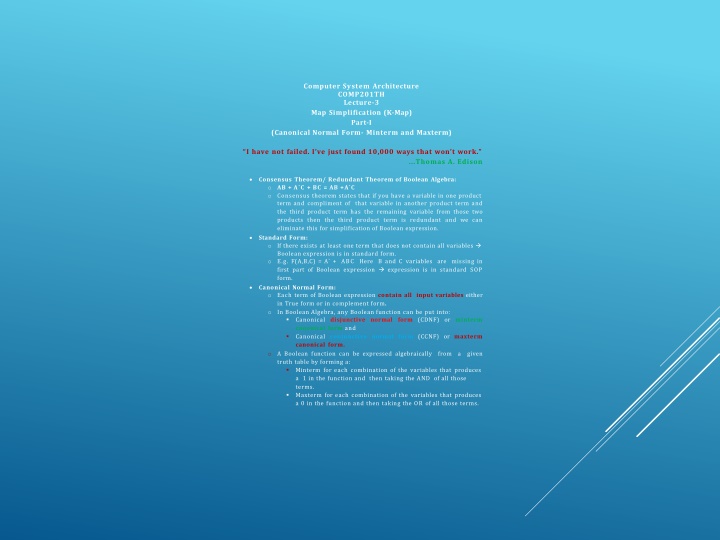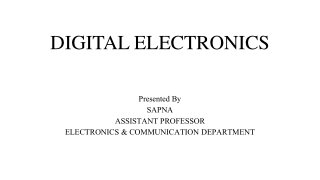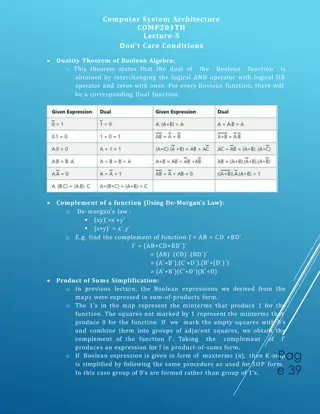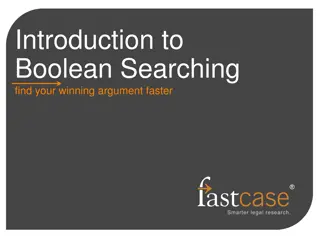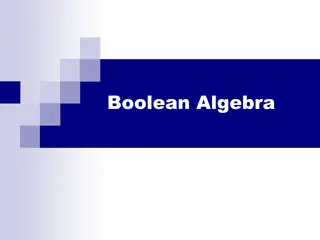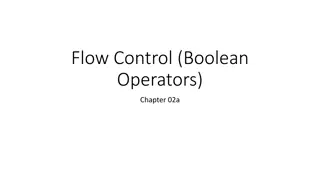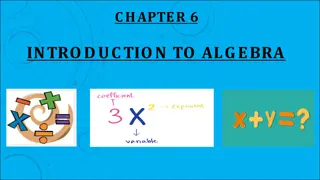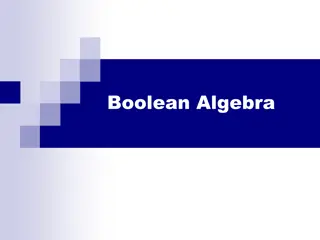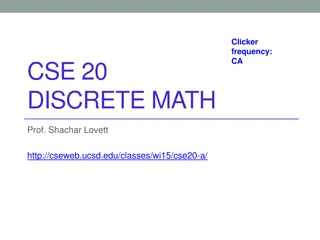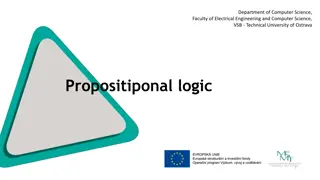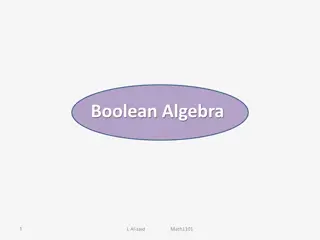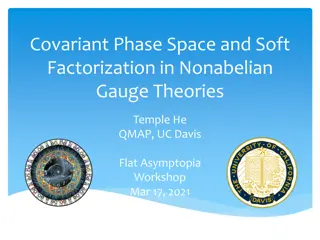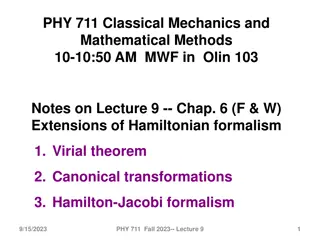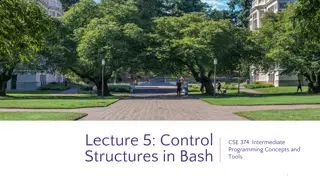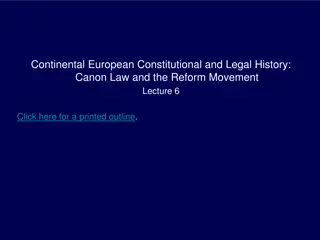Boolean Algebra: Canonical Normal Form, Minterms, and Maxterms Explained
Boolean algebra concepts including Canonical Normal Form, Minterms, and Maxterms are discussed in detail, along with examples and truth table representations. The Consensus Theorem and Redundant Theorem of Boolean Algebra are also explained, highlighting simplification techniques for Boolean expressions.
Download Presentation

Please find below an Image/Link to download the presentation.
The content on the website is provided AS IS for your information and personal use only. It may not be sold, licensed, or shared on other websites without obtaining consent from the author.If you encounter any issues during the download, it is possible that the publisher has removed the file from their server.
You are allowed to download the files provided on this website for personal or commercial use, subject to the condition that they are used lawfully. All files are the property of their respective owners.
The content on the website is provided AS IS for your information and personal use only. It may not be sold, licensed, or shared on other websites without obtaining consent from the author.
E N D
Presentation Transcript
Computer System Architecture COMP201TH Lecture-3 Map Simplification (K-Map) Part-I (Canonical Normal Form- Minterm and Maxterm) I have not failed. I ve just found 10,000 ways that won t work. ...Thomas A. Edison Consensus Theorem/ Redundant Theorem of Boolean Algebra: o AB + A`C + BC = AB +A`C o Consensus theorem states that if you have a variable in one product term and compliment of that variable in another product term and the third product term has the remaining variable from those two products then the third product term is redundant and we can eliminate this for simplification of Boolean expression. Standard Form: o If there exists at least one term that does not contain all variables Boolean expression is in standard form. o E.g. F(A,B,C) = A` + ABC Here B and C variables are missing in first part of Boolean expression expression is in standard SOP form. Canonical Normal Form: o Each term of Boolean expression contain all input variables either in True form or in complement form. o In Boolean Algebra, any Boolean function can be put into: Canonical disjunctive normal form (CDNF) or minterm canonical form and Canonical conjunctive normal form (CCNF) or maxterm canonical form. o A Boolean function can be expressed algebraically truth table by forming a: Minterm for each combination of the variables that produces a 1 in the function and then taking the AND of all those terms. Maxterm for each combination of the variables that produces a 0 in the function and then taking the OR of all those terms. from a given
Minterm: o A minterm of n variable is product of n literals in which each variable appears exactly once either in T or F form, but not in both. Minterms are called products because they are the logical AND of a set of variables. o Each minterm has value 1 for exactly one combination of values of variables. o E.g.: ABC (111) m7 o A function can be written as a sum of minterms, which is referred to as a minterm expansion or a standard sum of products. Maxterm: o A maxterm of n variables is sum of n literals in which each variable appears exactly once in T or F form, but not in both. Maxterms are called sums because they are the logical OR of a set of variables. o Each maxterm has a value of 0 for exactly one combination of values for variables. o E.g.: A + B + C` (001) M1 (the value is 0). Therefore; Mi = mi` o A function can be written as a product of maxterms, which is referred to as a maxterm expansion or a standard product of sums. Example consider the following truth table: A B C F 0 0 0 0 0 0 1 0 0 1 0 0 0 1 1 1 1 0 0 1 1 0 1 1 1 1 0 1 1 1 1 1 Using f =1, gives the SOP form: f = A`BC + AB`C` + AB`C + ABC` + ABC = A`BC + AB` + AB = A`BC + A = A + BC (Using Rule 1 of Simplification Law) Using f = 0, gives the POS form: f = (A + B + C) (A + B + C`) (A + B` + C) = (A +B) (A+B`+C) = A + BC
Minterm Notation Minterms present in f correspond with Maxterm Notation Maxterms present in f correspond with the 1 s of f in the truth table. the 0 s of f in the truth table. f = A`BC + AB`C` + AB`C + ABC` + ABC f = (A + B + C) (A + B + C`) (A + B` + C) The other way to represent f is : The other way to represent f is : f(A,B,C) = m3+m4+m5+m6+m7 f(A,B,C) = M0M1M2 Or or f(A,B,C) = m(3,4,5,6,7) f(A,B,C) = M(0,1,2) Another view: f(A,B,C) = 0.m0+0.m1+0.m2+1.m3+1.m4+1.m5+1.m6 +1.m7 * Remember * A` = 0 Minterm Sum Take terms whose value Disjunctiv (m) of is equal to 1 in the e Normal A = 1 Produ output of truth table. Form ct (SoP) Take terms whose value Maxterm Product Conjuncti A = 0 is equal to 0 in the (M) of Sums ve Normal A` = 1 output of truth table. (PoS) Form
Truth table representing minterm and maxterm Relation between m and M: o If the minterm expansion for f(A,B,C) = m3+m4+m5+m6+m7; what is the maxterm expansion for f(A,B,C)? o Choose those not present in the minterms. o So, the maxterm expansion for f(A,B,C) = M0M1M2 Q: Find the minterm expansion of following Boolean expression: f( A,B,C,D) = A`(B`+D)+ACD` = A`B`+A`D`+ACD` = A`B`(C+C`)(D+D`)+A`D(B+B`)(C+C`) + ACD`(B+B`) =A`B`C`D`+A`B`C`D+A`B`CD`+A`B`CD+A`BC`D+A`BCD+ABCD`+AB`CD` = 0000+0001+0010+0011+0101+0111+1110+1010 = m (0,1,2,3,5,7,10,14)
Q: Express the following function into sum of minterms maxterms: and product of f= (xy+z) (y+xz) Sol: f = (xy+z) (y+xz) = xy.y+xy.xz+z.y+z.xz =xy+xyz+zy+xz =xy+yz+xz+xyz Now, consider the truth table of f: x 0 0 0 0 1 1 1 1 y 0 0 1 1 0 0 1 1 z 0 1 0 1 0 1 0 1 f 0 0 0 1 0 1 1 1 f = 0.0 + 0.0 +0.0+0.0.0= 0 = M0 M0 M1 M2 m3 M4 m5 m6 m7 f = 1.0+0.1+1.1+1.0.1=1 =m5 The corresponding minterms are given by: f = xy+yz+xz+xyz = m3 + m5 +m6 +m7 = sum of minterms i.e. sum of products The corresponding maxterms are given by: f = (M0)(M1)(M2)(M4) = (x+y+z)(x+y+z`)(x+y`+z)(x`+y+z)
